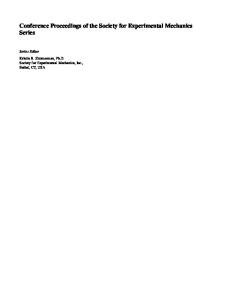Fabrication and Characterization of Single-crystal CVD Diamond Current Amplifier
- PDF / 289,981 Bytes
- 11 Pages / 432 x 648 pts Page_size
- 107 Downloads / 380 Views
Fabrication and Characterization of Single-crystal CVD Diamond Current Amplifier Joan E. Yater1, Jonathan L. Shaw1, Kevin L. Jensen1, Tatyana Feygelson2, Robert E. Myers3, Bradford B. Pate4, and James E. Butler2 1 Electronics Science and Technology Division, Naval Research Laboratory, Washington, DC 20375, U.S.A. 2 SAIC, Washington, DC 20003, U.S.A. 3 Beam-Wave Research Inc., Bethesda, MD 20814, U.S.A. 4 Chemistry Division, Naval Research Laboratory, Washington, DC 20375, U.S.A. ABSTRACT High-current-density cathodes are required for the development of high-power mm-wave and upper mm-wave devices, as well as for other electron beam applications. To address this need, a current amplifier stage is being developed that will multiply a primary electron-beam current (via the secondary-electron multiplication process) and then emit the amplified beam so as to achieve a current gain of 50-100. Diamond is a particularly promising current amplification source due to the negative electron affinity present at stable hydrogenated surfaces. As such, we are fabricating current amplifiers using single-crystal CVD diamond grown at NRL, with our growth effort focused on reducing the impurity concentration in the epitaxial diamond and on fabricating microns-thick freestanding films. The current amplification characteristics of the diamond films are examined using secondary-electron-emission measurements in both reflection and transmission configurations. In our initial study of an 8.3-μm-thick CVD diamond film, the single-crystal diamond is shown to have superior transport and emission properties compared to similar polycrystalline material. While transmission gains have been obtained under field-free conditions from the unbiased diamond film, we are striving to increase the gain by increasing the transport efficiency in a biased amplifier structure. Towards this end, recent efforts have focused on optimizing the bonding and metallization processes as needed to establish and control the internal electric field. In addition, Monte Carlo simulations are being used to predict the optimal material and device parameters needed to achieve high amplifier gain and low energy spread. INTRODUCTION Diamond has attracted much attention in the past due to the negative electron affinity (NEA) present at the hydrogenated surface [1] and the potential for efficient electron emission at such surfaces. Unfortunately, the absence of an internal electron supply in diamond has hampered cathode development efforts. However, while diamond may not yet represent a viable primary electron source material, there are exciting opportunities to exploit the secondary electron emission capabilities of NEA diamond films. For example, we are using CVD diamond to develop an electron current amplifier stage that would multiply the beam current produced by a primary cathode through the generation of secondary electrons. By optimizing the transport and emission processes in the diamond amplifier film, an emitted electron beam can be produced that exhibits both higher cur
Data Loading...










